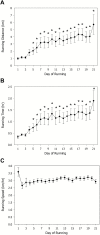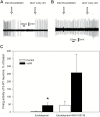Effect of Physical Exercise and Acute Escitalopram on the Excitability of Brain Monoamine Neurons: In Vivo Electrophysiological Study in Rats
- PMID: 28430979
- PMCID: PMC5492809
- DOI: 10.1093/ijnp/pyx024
Effect of Physical Exercise and Acute Escitalopram on the Excitability of Brain Monoamine Neurons: In Vivo Electrophysiological Study in Rats
Erratum in
-
Erratum.Int J Neuropsychopharmacol. 2017 Nov 1;21(1):95. doi: 10.1093/ijnp/pyx084. Int J Neuropsychopharmacol. 2017. PMID: 29099974 Free PMC article. No abstract available.
Abstract
Background: The antidepressant effect of physical exercise has been reported in several clinical and animal studies. Since serotonin, norepinephrine, and dopamine play a central role in depression, it is possible that the beneficial effects of physical exercise are mediated via monoamine pathways. This study investigates the effects of voluntary wheel running on the excitability of monoamine neurons.
Materials and methods: Male Sprague-Dawley rats were used in the study. Voluntary wheel running (VWR) rats were housed in individual cages with free access to a running wheel, while control animals were housed in standard laboratory cages. After three weeks, the rats were anesthetized, and in vivo electrophysiological recordings were taken from dorsal raphe nucleus serotonin neurons, locus coeruleus norepinephrine neurons, and ventral tegmental dopamine neurons.
Results: VWR stimulated activity in serotonin, but not in norepinephrine or dopamine neurons. Subsequently, acute administration of the selective serotonin reuptake inhibitor escitalopram in control rats led to complete suppression of serotonin neurons; this suppression was reversed by subsequent administration of selective antagonist of serotonin-1A receptors, WAY100135. Escitalopram induced only partial inhibition of serotonin neurons in the VWR rats while WAY100135 increased the firing activity of serotonin neurons above the baseline value.
Conclusions: The beneficial effect of physical exercise on mood is mediated, at least in part, via activation of serotonin neurons. Physical exercise can potentiate the response to selective serotonin reuptake inhibitors by increasing the basal firing activity and diminishing selective serotonin reuptake inhibitor-induced inhibition of serotonin neurons.
Keywords: Voluntary wheel running (VWR) rats; dopamine; norepinephrine; selective serotonin reuptake inhibitors (SSRIs); serotonin (5-HT).
© The Author 2017. Published by Oxford University Press on behalf of CINP.
Figures



Similar articles
-
Effects of acute and long-term administration of escitalopram and citalopram on serotonin neurotransmission: an in vivo electrophysiological study in rat brain.Neuropsychopharmacology. 2005 Jul;30(7):1269-77. doi: 10.1038/sj.npp.1300686. Neuropsychopharmacology. 2005. PMID: 15702136
-
Effects of sustained serotonin reuptake inhibition on the firing of dopamine neurons in the rat ventral tegmental area.J Psychiatry Neurosci. 2009 May;34(3):223-9. J Psychiatry Neurosci. 2009. PMID: 19448853 Free PMC article.
-
Long-term administration of cariprazine increases locus coeruleus noradrenergic neurons activity and serotonin1A receptor neurotransmission in the hippocampus.J Psychopharmacol. 2020 Oct;34(10):1143-1154. doi: 10.1177/0269881120936891. Epub 2020 Jul 20. J Psychopharmacol. 2020. PMID: 32684081
-
[Escitalopram: a selective inhibitor and allosteric modulator of the serotonin transporter].Encephale. 2007 Dec;33(6):965-72. doi: 10.1016/j.encep.2007.11.001. Epub 2007 Dec 11. Encephale. 2007. PMID: 18789789 Review. French.
-
[Consequences of the monoaminergic systems cross-talk in the antidepressant activity].Encephale. 2018 Jun;44(3):264-273. doi: 10.1016/j.encep.2018.05.001. Epub 2018 May 22. Encephale. 2018. PMID: 29801770 Review. French.
Cited by
-
Electrophysiology and Behavioral Assessment of the New Molecule SMe1EC2M3 as a Representative of the Future Class of Triple Reuptake Inhibitors.Molecules. 2019 Nov 20;24(23):4218. doi: 10.3390/molecules24234218. Molecules. 2019. PMID: 31757051 Free PMC article.
-
The moderating effect of physical activity on the relationship between neutrophil count and depressive symptoms.Sci Rep. 2024 Jun 2;14(1):12647. doi: 10.1038/s41598-024-63432-x. Sci Rep. 2024. PMID: 38825659 Free PMC article.
-
Intervention Effect of Aerobic Exercise on Physical Fitness, Emotional State and Mental Health of Drug Addicts: A Systematic Review and Meta-Analysis.Int J Environ Res Public Health. 2023 Jan 27;20(3):2272. doi: 10.3390/ijerph20032272. Int J Environ Res Public Health. 2023. PMID: 36767656 Free PMC article.
-
Therapeutic effects of exercise-accompanied escitalopram on synaptic potency and long-term plasticity in the hippocampal CA1 area in rats under chronic restraint stress.Iran J Basic Med Sci. 2022 Dec;25(12):1460-1467. doi: 10.22038/IJBMS.2022.66718.14629. Iran J Basic Med Sci. 2022. PMID: 36544519 Free PMC article.
-
Effects of a Two-Month Exercise Training Program on Concurrent Non-Opiate Substance Use in Opioid-Dependent Patients during Substitution Treatment.J Clin Med. 2024 Feb 6;13(4):941. doi: 10.3390/jcm13040941. J Clin Med. 2024. PMID: 38398255 Free PMC article.
References
-
- Bakos J, Hlavacova N, Makatsori A, Tybitanclova K, et al. (2007) Oxytocin levels in the posterior pituitary and in the heart are modified by voluntary wheel running. Regul Pept 1–3:96–101. - PubMed
-
- Bjornebekk A, Mathe AA, Brene S. (2010) The antidepressant effects of running and escitalopram are associated with levels of hippocampal NPY and Y1 receptor but not cell proliferation in a rat model of depression. Hippocampus 7:820–828. - PubMed
-
- Blier P, Pineyro G, el Mansari M, Bergeron R, et al. (1998) Role of somatodendritic 5-HT autoreceptors in modulating 5-HT neurotransmission. Ann NY Acad Sci 861:204–216. - PubMed
-
- Blumenthal JA, Sherwood A, Babyak MA, Watkins LL, et al. (2012b) Exercise and pharmacological treatment of depressive symptoms in patients with coronary heart disease: results from the UPBEAT (Understanding the Prognostic Benefits of Exercise and Antidepressant Therapy) study. J Am Coll Cardiol 12:1053–1063. - PMC - PubMed
Publication types
MeSH terms
Substances
LinkOut - more resources
Full Text Sources
Other Literature Sources

